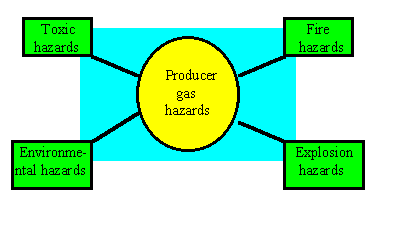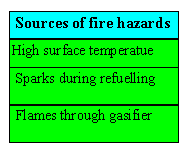
Producer gas, the mixture of carbon monoxide, hydrogen, methane and other gases, is hazardious, if it is not handled and used properly. Poisonous component of producer gas is carbon monoxide. All hazards associated with use of producer gas are descriebed here.
Fire hazards

Fire risks can be minimized by taking following precautions
- Insulation of hot parts of system
- Insulation of double sluice filling device
- Installation of back-firing valve in gasifier inlet
Explosion hazards
Explosion can occur if the producer gas is mixed with sufficient amount of air to form explosive mixture. This may happens because of following several reasons :
- Air leakage into the gas system
- Air penetration during refuelling
- Air leakage into cold gasifier still containing gas which can ignite
Air leakage into the gas system does not generally give rise to explosions. To avoid the chance of explosion due presence of producer gas, if any, in cold system, it is necessary to ventilate cold system before igniting the fuel.
Toxic hazards
 Producer gas consists of carbon monoxide, which is extremely toxic and dangerous as it combine with haemoglobin in the blood, preventing oxygen absorption and distribution. Carbon monoxide concentration of 50 PPM produce no effect. As concentration increases, there arises problems of headache, dizziness and even death also. No chronic symptons can occur as the result of prolonged inhalation of relatively small amounts of carbon monoxide. Fortunately, there is less chance of gas escape during operation as gasification system works under suction. However, situtation is quite different during starting and closing installations. To avoid the trapping of gas, it is recommended to install the gasifier plant in the open air
Producer gas consists of carbon monoxide, which is extremely toxic and dangerous as it combine with haemoglobin in the blood, preventing oxygen absorption and distribution. Carbon monoxide concentration of 50 PPM produce no effect. As concentration increases, there arises problems of headache, dizziness and even death also. No chronic symptons can occur as the result of prolonged inhalation of relatively small amounts of carbon monoxide. Fortunately, there is less chance of gas escape during operation as gasification system works under suction. However, situtation is quite different during starting and closing installations. To avoid the trapping of gas, it is recommended to install the gasifier plant in the open air Environmental hazards
During the gasification of biomass, ashes and condensate (mainly water) are produced. Ashes do not contribute to any environmental hazards and can be safely disposed. However, for the tar containing condensate, the situation is different and disposal of those form can have undesirable environmental effects. No specific information is available about the bio-degradation of the phenolic and tarry constituents of the condensates. Properties of exhuast emmission of engines running on producer gas is generally acceptable.
To retun to main page click here
This page is developed and maintened by :
Chandrakant Turare ,
ARTES Institute,
University of Flensburg
Flensburg, Germany
Email: chand@uni-flensburg.de